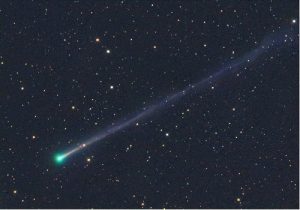With the exception of US10 Catalina at the beginning of the year, 2016 was a bit of a damp squid for bright comets when compared to recent years. So what comets are in store for 2017? Are there any more naked eye comets on the horizon? Well, there are a few short period comets in 2017 that reach within binocular viewing brightness. One of which should reach just within naked eye visibility. There is also a hyperbolic comet but not reaching any significant brightness to write home about.
Comet 45P/Honda-Mrkos-Pajdusakova
This short period comet is expected to reach closest approach in 2017 at a distance of 0.08au. The comet is brightened rapidly throughout November 2016, however was only visible to southern sky observers. Northern observers had a small window of opportunity to observe it at the end of 2016 as perihelion approached. The comet then re-emerged in the northern hemisphere in February. Imaged above on its last closest approach in 2011, this comet has had a few close encounters with Jupiter in the past making some noticeable changes to the comet’s orbit. Throughout January and February 2017, 45p was expected to reach magnitude 6 after it re-emerged from conjunction, however sightings disappointed as it was revealed that it had lost its tail and appeared quite faint and diffuse at magnitude 8. The comet covered plenty of ground as it moved rapidly through Capricornus, Aquilla, Hercules, Corona Borealis, Bootes, Coma Berenices and Leo through the spring. By this time it faded to around magnitude 10. Read more…
2P/Encke
Gracing our skies every 3.3 years, this regular visitor was the first periodic comet discovered after Halley’s Comet. With a nucleus of 4.8km, the comet reached perihelion on 10 March, 2017 and reached a fairly respectable brightness of magnitude 7. Positioned in Pisces throughout February for northern observers, the comet quickly brightened making it visible in binoculars by mid month. The comet then moved rapidly in to Aquarius and in to northern dusk by early March. Read more..
41P/Tuttle-Giacobini-Kresak
Another short period comet with more promising prospects than the comets above, was expected to reach magnitude 5 in the Spring of 2017 bringing it within naked eye visibility however, it did not quite reach this milestone. With a nucleus of an estimated 1.4 kilometers in diameter and a reputation for flaring, this comet reaches perihelion at the end of March. Well placed for northern sky observers from January until June, the comet was still a treat for binocular observers. A notable photographic opportunity arose at the end of April when the comet passed within 5 degrees of Globular Cluster, M92 . Read More…
C/2015 V2 (Johnson)
Discovered on 3 November 2015 by Jess Johnson of the Catalina Sky Survey, C/2015 V2 (Johnson) is a hyperbolic comet. It reached Perihelion in June 2017, the comet was well placed for northern hemisphere observers in the months leading to this. By mid-February the icy rock moved in to Hercules becoming a late evening object visible for the rest of the night. By May, the comet reached magnitude 6 which is well within binocular viewing brightness before it plummeted south becoming un-viewable to northern sky observers by July. Southern observers will be able to continue observing the object until the end of 2017. Read More…
Comet C/2017 O1 (ASAS-SN)
Discovered by the All-Sky Automated Survey for Supernovae (ASAS-SN) on 19th July, 2017, Comet C/2017 O1 was shining at magnitude 15 in Cetus. The comet has taken everyone by surprise when it brightened a staggering hundred times to magnitude +10. Now readily visible in backyard telescopes or decent sized binoculars from the southern hemisphere, the comet is expected to continue to brighten and move to the northern hemisphere from September October. Read More…

